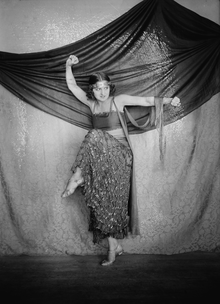Albertina Rasch
Albertina Rasch (January 19, 1891[1] – October 2, 1967) was a naturalized American dancer and choreographer.
Albertina Rasch | |
|---|---|
 Albertina Rasch, circa 1915 | |
| Born | January 19, 1891 |
| Died | October 2, 1967 (aged 76) Woodland Hills, Los Angeles, California, U.S. |
| Occupation | Dancer, choreographer, ballerina |
| Spouse(s) | Dimitri Tiomkin (m. 1927–1967) |
Early life
Rasch was born in 1891 (although she would later shave five years off her age), in Vienna (in what was then Austria-Hungary), to a family of Polish Jewish descent. She studied at the Vienna State Opera Ballet school and became leading ballerina at the New York Hippodrome in 1911.[3]
Career
She formed her own dance troupe (The Albertina Rasch Girls) and the Rasch Ballet, starred in a number of Ziegfeld productions, appeared at the Moulin Rouge, performed with Josephine Baker, toured with Sarah Bernhardt, and opened a Manhattan dance studio (where Bill Robinson taught tap) before adapting her classical training and techniques for the Broadway theatre and films.[4]
Rasch's early stage work for such projects as George White's Scandals evoked the Black Crook tradition of inserting fantasy dance sequences that had little to do with the plot between book scenes. In 1930 she created the dances for the revue, Three's A Crowd. The New York Times said "... Mme. Rasch, director of the dances, who has made a pleasant departure from music show routine . . ."[5] She soon established herself as a creative force with a routine she devised for Tilly Losch in the 1931 revue, The Band Wagon. Wearing gloves covered with blacklight paint, Losch stood in front of a mirror on a darkened stage and performed a "ballet" in which only her hands could be seen to the Arthur Schwartz and Howard Dietz song "Dancing in the Dark".
Rasch also helped establish Cole Porter's "Begin the Beguine" as a popular standard by choreographing it to an ethnic dance in Jubilee (1935).[6] Additional Broadway credits include The Three Musketeers, Show Girl, The Bohemian Girl, The Great Waltz, and Lady in the Dark.
Rasch served as choreographer and/or dance director for a number of musical films, including The Merry Widow (1934) with Jeanette MacDonald and Maurice Chevalier, Broadway Melody of 1936 (1936) with Jack Benny and Eleanor Powell, Rosalie (1937) with Powell and Nelson Eddy, The Girl of the Golden West (1938) with MacDonald and Eddy, Marie Antoinette (1938) with Norma Shearer, and Broadway Melody of 1940 (1940) with Fred Astaire.
Footage of Rasch filmed for the unfinished Metro-Goldwyn-Mayer musical The March of Time (1930) was used in the MGM film Broadway to Hollywood (1933) with Frank Morgan and Alice Brady. MGM also reused her "Chinese Ballet" from Lord Byron of Broadway (1930) in the short film Roast Beef and Movies (1934).
Personal life
Rasch married composer Dimitri Tiomkin in 1927; they remained married until her death on October 2, 1967 at age 76 in Woodland Hills, California following a prolonged illness.
References
- JSTOR 1567635
- "Player". Illinois Digital Newspaper Collections. January 17, 1913. p. 1. Retrieved 22 July 2015.
- Britannica Online Encyclopedia
- Albertina Rasch at BuckinghamHotel.com Archived 2007-10-04 at the Wayback Machine
- The New York Times, Thursday, October 156, 1930, p. 33
- The Rise and Fall of the Broadway Musical by Mark N. Grant, published by the University Press of New England (2005), pp 252-54 ISBN 1-55553-642-5
External links
| Wikimedia Commons has media related to Albertina Rasch. |